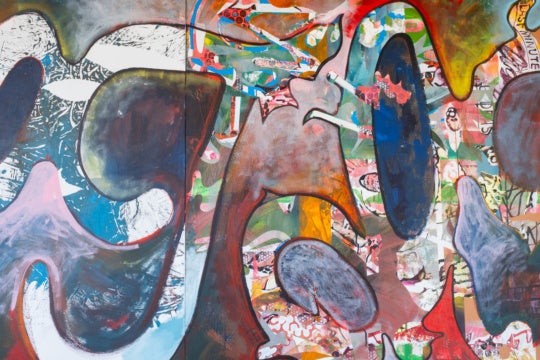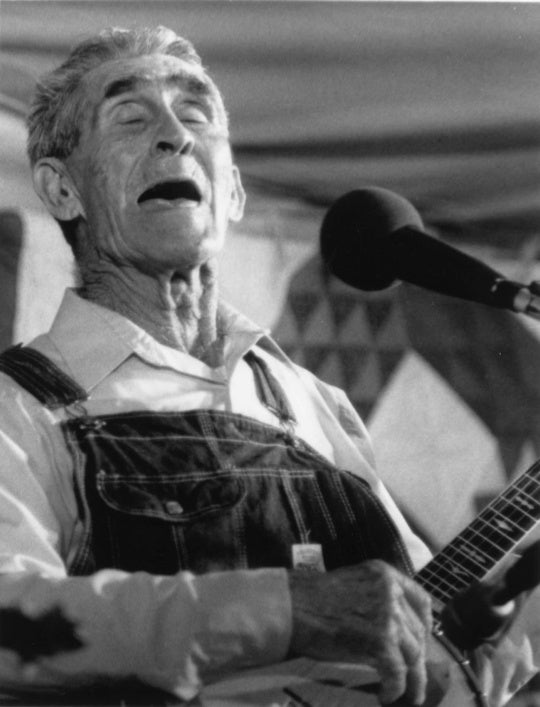
What does it mean to be authentically Asian? How about Asian American, or Slovenian American for that matter? The five Korean artists in {Poem 88}’s exhibition “Blue Willow,” on view through April 29, ask these questions through images that are at times vibrant, graphically logical, culturally quizzical, and beautiful without apology.

The exhibition’s title comes from the blue willow pattern, a ceramics tradition with a mixed-up Orientalist history. As John Johnston, professor of Asian art at Hong Kong Baptist University, explains in the gallery handout, the exact origins of the pattern are a matter of debate. It is clear, however, that the imagery was popularized by English manufacturers in the late 18th century and, thus, was an invention of the West and not the East. In later years, imitation encouraged more imitation as Chinese potters began incorporating the romanticized design into their own wares.
Jiha Moon’s Blue Willow YOLO shares inspiration with the show’s title. One of the few three-dimensional works on display, its teardrop shape suggests a whimsical water pitcher. The knotted blue-hair tassel and curvilinear designs suggest an artist who respects her cultural inspirations and yet is unafraid of pirating them for new application. Just as Moon’s YOLO sculpture reminds us, you only live once—why stay paralyzed with questions of authenticity? Why not borrow and recombine traditions, not simply by “going with the flow” but by dashing through, over, and beyond?

At first, Namwon Choi’s diptych reminded me of a traditional Chinese landscape. Two acrylic paintings hang side by side; Passage (Forest) features a pattern of treetops while Passage (Water) shows ocean waves. Both images have a designerly, three-tier composition using straight horizontal lines to evoke the idea of multiple horizons, a panorama experienced at three different times of day or season. The effect is reminiscent of collage or screen printing, yet the blue contours were painted meticulously in photorealistic detail. It’s worth noting a change in Choi’s work, as her previous work was painterly and figural.
Wihro Kim’s Point of Departure highlights his interest in dreamlike spaces. Washed-out grays and blues form the outline of a mysterious bathroom door. Is this a mundane private space, or is it a portal into some lost memory? His Pink Interior shows a solid sense of composition, an unforced dance of vertical and horizontal elements.

A starburst of honeybees blooms against a harsh field of black in The Return by Jaeyoun Shin. The clustered insects form a flat pattern reminiscent of geographic contours, like the outline of a subcontinent, floating against the darkness of outer space. Two fiendish little fish observe from below, rendered in a style that perhaps pays homage to Dutch painter Hieronymus Bosch. Shin’s use of Sakura Gelly Roll pens is unorthodox, but it helps heighten the childlike yet chaotic sense of danger in her mindscapes.

Shin’s interest in flatness parallels the paintings of InKyoung Chun, who in recent years has turned more toward abstraction. Chun’s Rooftop 4 is a playground of primary color subdued by a snowstorm of pure white. Everything is hushed and pushed forward toward the viewer, like a 1950s sitcom set in Edwin Abbott’s Flatland. The effect evokes European modernists such as Henri Matisse or even Paul Klee, while still respecting the Asian tradition of negative space embodied by blank white paper.
Moon and Chun are familiar faces around Atlanta, both having exhibited internationally. Kim earned his BFA from Georgia State University in 2015 before earning honors from MINT Gallery as well as WonderRoot last year. Like Moon and Chun, Shin and Choi started their studies in Korea before moving to the United States. All five of the artists, however, finished their studies stateside, and four of them are proud alumni of Georgia-based colleges.
This exhibition of 12 works in oil, ink, watercolor, and porcelain isn’t another show celebrating minorities just for the sake of inclusion. The essay on blue willows was a smart addition by the gallery, and as the curator says, many of these artists talk regularly and influence each other’s work. What counts is the conversation among the artists, their inspirations, and their contributions to the larger creative community.
Jeremy Abernathy, a cofounder of BURNAWAY who has written extensively on the Atlanta scene, is back.




